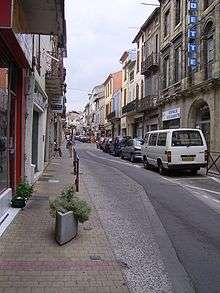Pamiers
Pamiers (French pronunciation: [pa.mje]; Occitan: Pàmias) is a commune in the Ariège department in the Occitanie region in southwestern France. It is a sub-prefecture of the department. Although Pamiers is the largest city in Ariège, the capital is the smaller town of Foix. The seat of the Bishop of Pamiers is at the Pamiers Cathedral. The current mayor of the town is André Trigano, who has held the position since his initial election on 18 June 1995.[2]
Pamiers | |
|---|---|
Subprefecture and commune | |
 A general view of Pamiers | |
 Coat of arms | |
Location of Pamiers 
| |
 Pamiers  Pamiers | |
| Coordinates: 43°07′03″N 1°36′42″E | |
| Country | France |
| Region | Occitanie |
| Department | Ariège |
| Arrondissement | Pamiers |
| Canton | Pamiers-1 and 2 |
| Intercommunality | Pays de Pamiers |
| Government | |
| • Mayor (2014–2020) | André Trigano (DVD) |
| Area 1 | 45.85 km2 (17.70 sq mi) |
| Population (2017-01-01)[1] | 15,675 |
| • Density | 340/km2 (890/sq mi) |
| Time zone | UTC+01:00 (CET) |
| • Summer (DST) | UTC+02:00 (CEST) |
| INSEE/Postal code | 09225 /09100 |
| Elevation | 256–473 m (840–1,552 ft) (avg. 298 m or 978 ft) |
| 1 French Land Register data, which excludes lakes, ponds, glaciers > 1 km2 (0.386 sq mi or 247 acres) and river estuaries. | |
Geography
Pamiers is located on the Ariège River.
The town of Pamiers is famous for its three bell towers and for being the birthplace of Gabriel Fauré, one of the greatest French musicians and composers of the late 19th and early 20th century. It also boasts awards for Ville fleurie, the equivalent of "town in bloom". Local facilities include good restaurants, bars, supermarkets, large public indoor and outdoor swimming pools (one of which is 50m).

Pamiers lies in an ancient alluvial plain of the Ariège River in the area called La Basse Ariège, noted for its rich fertile soil ideal for agriculture. Pamiers has 17,000 inhabitants, the Appaméens, and is the economic capital of the Ariège, being the most important town in the department.
The town itself dates back to the 5th century. The origin of its name is subject to debate. A certain school of linguists tends to believe that it was derived from the fact that, when Pamiers was founded, its new inhabitants were given land parcels measured in pams', from empan (from the Latin "pannus" meaning "piece of cloth"). Originally it was called Ville de Pams. Another explanation is one involving Roger II de Foix, who had gone to a crusade in the region of Apamea in Syria and who, upon his return to France, gave his castle and domain the name of one of his battles: Castrum Appamiae, name later on given to the town. The fact that Pamiers' inhabitants are called Appaméens would seem to favour this hypothesis. In the 18th century a plural stance on the word was introduced making the name "Apamias" derived from ecclesiastical language and also similar to the Occitan language. The Occitan name "Pamias" can be seen on the town sign, alongside the French name Pamiers, as one enters the town via the old route from Toulouse, RN20.
The main square of Pamiers, Place de la République, is paved in red marble. Every week, three large open-air farmers' markets are held, plus a flea market every Sunday morning. Nearby are the old Tour des Cordeliers and the large Church of Notre-Dame-du-Camp.
Population
| Historical population | ||
|---|---|---|
| Year | Pop. | ±% |
| 1793 | 4,954 | — |
| 1800 | 6,174 | +24.6% |
| 1806 | 5,646 | −8.6% |
| 1821 | 5,919 | +4.8% |
| 1831 | 6,048 | +2.2% |
| 1836 | 6,905 | +14.2% |
| 1841 | 6,485 | −6.1% |
| 1846 | 7,667 | +18.2% |
| 1851 | 7,770 | +1.3% |
| 1856 | 7,631 | −1.8% |
| 1861 | 7,910 | +3.7% |
| 1866 | 7,877 | −0.4% |
| 1872 | 8,690 | +10.3% |
| 1876 | 8,967 | +3.2% |
| 1881 | 11,726 | +30.8% |
| 1886 | 11,944 | +1.9% |
| 1891 | 11,143 | −6.7% |
| 1896 | 10,657 | −4.4% |
| 1901 | 10,886 | +2.1% |
| 1906 | 10,449 | −4.0% |
| 1911 | 10,017 | −4.1% |
| 1921 | 12,012 | +19.9% |
| 1926 | 12,131 | +1.0% |
| 1931 | 13,164 | +8.5% |
| 1936 | 14,035 | +6.6% |
| 1946 | 12,026 | −14.3% |
| 1954 | 12,822 | +6.6% |
| 1962 | 13,297 | +3.7% |
| 1968 | 14,564 | +9.5% |
| 1975 | 14,325 | −1.6% |
| 1982 | 13,345 | −6.8% |
| 1990 | 12,965 | −2.8% |
| 1999 | 13,417 | +3.5% |
| 2008 | 15,857 | +18.2% |
Personalities

Pamiers was the birthplace or hometown of:
- Marc-Guillaume Alexis Vadier (1736-1828), politician at the time of the French Revolution
- Caroline Montigny-Rémaury (1843–1913), pianist
- Gabriel Fauré (1845-1924), composer
- Théophile Delcassé (1852-1923), statesman
- Pope Benedict XII, (ca. 1280-1342), bishop of Pamiers in the 1320s
- Swanne Gauthier, basketball player
- Yoann Huget, rugby player
Transportation
- Gare de Pamiers
See also
- 1st Parachute Chasseur Regiment, a regiment based in the commune
- Communes of the Ariège department
- County of Foix
- List of medieval bridges in France
Notes
- "Populations légales 2017". INSEE. Retrieved 6 January 2020.
- "Municipales à Pamiers : maire depuis 1995, André Trigano part pour un cinquième set". ladepeche.fr (in French).
References
External links
| Wikimedia Commons has media related to Pamiers. |
- Official website (in French)
- Tourist office website (in French)
- . Encyclopædia Britannica (11th ed.). 1911.